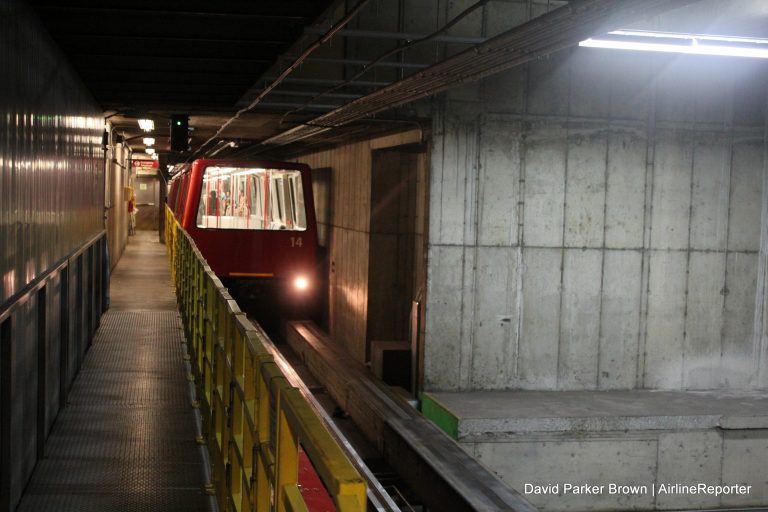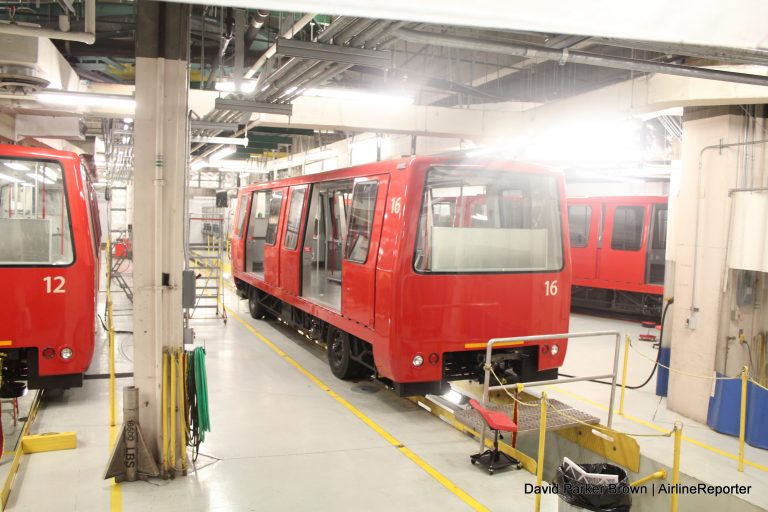Written by David Parker Brown, Editor-in-Chief and Founder of Airline Reporter
The Seattle-Tacoma International Airport (SEA) has been my home airport most of my life. I have seen the many changes over the years and I am proud to call it mine. Growing up, I lived in Oak Harbor, WA (about 90min northwest of Seattle) and I would often fly by myself from there to Reno, NV (where my dad lived). After I was 12, I didn’t need to be escorted and I would usually have a few hours of layover from my tiny home airport (ODW) to SEA. To burn time, I would often ride one of the satellite trains to the remote terminals and watch the airplanes come and go. Being a kid, sometimes I would just ride the train a few laps for fun.
Throughout the years, I always wondered how they worked. I knew there wasn’t a person controlling them, but how were they programmed? How many cars were there? How did they get fixed? And how fast can they go? Luckily adult-me was in a position to find those answers, so I reached out to SEA to get a behind-the-scenes tour of their train operations. Once again, the adult-me was making the child-me jealous.
Train, tram, shuttle. Whatever you want to call the thing, there are similar people movers at airports around the world. SEA calls theirs a “train” and they have quite a few reasons to be proud of the operation. And they get operated quite a bit — the airport sees about 43 million passengers per year and the trains carry about 16 million of those.
For those of you not familiar with Seattle’s airport, there is the main terminal and then north and south satellite terminals. There are three train systems that help connect them all.
Since there is really no other way to get from the main terminal to the satellites, it is vital to keep the trains running at an optimum level — and they do. The system has a 99.9% uptime rate — compare that the reliability of even the best airlines. When the trains do go offline, they have enough stored power locally to get passengers to the next station. If they cannot get the trains running again in a timely manner, they will break out the buses to get passengers to the satellites — but that hasn’t happened since 2006.
If track maintenance is needed, they do it in the middle of the night. That is becoming more difficult, as SEA increases the number of flights in the wee hours of the morning. Sometimes they will have to operate with just one train per segment and put them in shuttle mode (be prepared for delays on those days).
The first train system was installed 43 years ago. Since then, it has become the system that others (even non-airports) want to emulate. The first system came from Westinghouse, but in 2002-2003, it was all updated to Bombardier. Yup. Bombardier trains working the Seattle airport, home of Boeing (yeah, yeah, it is headquartered in Chicago, but whatever).
I wasn’t sure what to call these things. I had always called them a “tram.” The official outward name is “satellite train system.” To those who work on them, they have always been called a “train.” This was a little weird to me, since they run on truck tires. Each car is attached to an electric rail that power electric motors that turn tires. Really, call them what you want, they are cool.
Actually, I did ask if they had fun nicknames for each car, but unfortunately they do not, they are just called, 1, 2, 3, 4, etc. I suggested that maybe the airport do some sort of social media naming contest, but that does come with some risks.
SEA does their own maintenance, which is not common (LAS is only other airport that does). This ends up saving about 40% in maintenance costs and it also means that they have a pretty slick setup to get the work done. They have 21 cars, where about 13 are in service at any given time.
…
David Parker Brown is Founder and Editor-in-Chief of AirlineReporter. He has written, consulted, and presented on multiple topics relating to airlines and travel since 2008. He has been quoted and written for a number of news organizations, including BBC, CNN, NBC News, Bloomberg, and others. He is passionate about sharing the complexities, the benefits, and the fun stuff of the airline business.
Tags: AirlineReporter, airports, David Parker Brown, People Mover, Seattle, Seattle-Tacoma Airport, Tram, Washington










 RSS Feed
RSS Feed